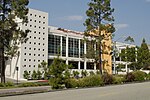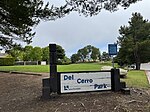Palos Verdes Peninsula High School
1964 establishments in CaliforniaAll pages needing cleanupEducational institutions established in 1964Palos Verdes Peninsula Unified School DistrictPublic high schools in Los Angeles County, California ... and 1 more
Use mdy dates from December 2014
Palos Verdes Peninsula High School is a public high school in Rolling Hills Estates, Los Angeles County, California, United States, in the Los Angeles metropolitan area. As of 2023, it is a top-ranked school in the Los Angeles, CA Metro Area (#16) and California (#42), according to US News & World Report.
Excerpt from the Wikipedia article Palos Verdes Peninsula High School (License: CC BY-SA 3.0, Authors).Palos Verdes Peninsula High School
Silver Spur Road,
Geographical coordinates (GPS) Address Website External links Nearby Places Show on map
Geographical coordinates (GPS)
| Latitude | Longitude |
|---|---|
| N 33.77801 ° | E -118.37353 ° |
Address
Palos Verdes Peninsula High School
Silver Spur Road
90274 , Rolling Hills Estates
California, United States
Open on Google Maps






